Managing and Minimizing Grief and Loneliness in an Assisted Living Facility or Long-Term Care Environment
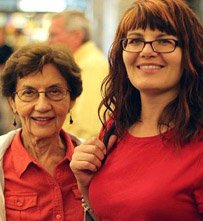
Summary: We recently visited an assisted living/memory care facility, and our interaction with one particular resident left a lasting impression on us about grief and loneliness. We talk about some of the strategies this particular facility uses to minimize and manage loneliness and isolation.
Written By: D.Besnette
I have been wanting to reach out to facilities, to interview their administrators to start learning about, Martha’s Room at the assisted living facilityand sharing with my visitors what it is like to operate, and to live in an assisted living environment. This opportunity offered a good chance to do both. However, I was not fully prepared for what I was going to experience. This visit, for me, was incredibly profound, and moving as a result of an interaction I had with one of the residents – I will call her Martha.
The visit to the facility was to happen on a Thursday, and as I was driving up for my appointment, I was playing scenarios in my mind of what the visit might be like. I, like many people, have a few different images of Alzheimer’s facilities – of which, one is based on the old stereotype of a very stale, depressing, and institutional-like setting. Fortunately, I do know, and remind myself that this stereotype is becoming a thing of the past. Nowadays, one is more likely to experience a setting where, although the residents are not of full mental or physical capacity, they are treated with loving kindness, and they are engaged in activities, and they are still treated like human beings. I was hoping for, and expecting the latter scenario.
Fortunately, that is what I was met with.
The facility was great. As soon as I walked in, I could see many of the residents sitting in the ‘fireplace room’ trading stories, and talking about a variety of things – sending the occasional chuckle down the hallway. Some of the other residents were in various other common rooms of the house – reading, sitting or napping.
I did not witness one resident spending time in their own room (most all of the room doors were open, and most of them were labeled with the resident’s name to help them to remember which one is theirs.)
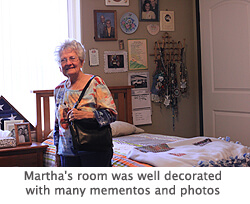
I asked to take some photos, and video of the facility, including, if possible, some of the private rooms. I received permission to use Martha’s room. Her door was also open, although at the moment, she was not there.
I noticed on the wall that she had quite a few photographs of her husband – many of them were displayed with various mementos from his service in the military. I didn’t think much of it other that it was quite a tribute to her spouse.
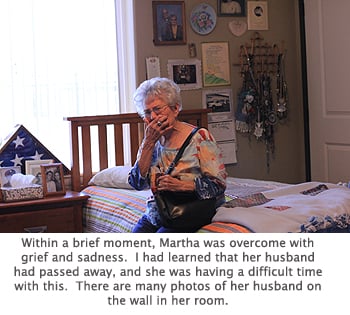
Martha was quickly griefstricken and lonelyAs I was photographing the room, Martha wandered down the hall to say hello to us. I found her to be immediately delightful, and she had a smile that seemed to stretch across the hallway. I thanked her for allowing us to use her room, and she seemed excited and happy to have us there. She entered her room, and sat down on her bed – smile still intact. A moment later, she glanced at her wall, and the tribute to her husband, and she immediately broke down crying. The look and expression on her face at that moment is one I will never forget. Within the snap of a finger, she went from near giddiness to profound grief, and loneliness. There could have been 100 people in her room, but after seeing the photos on her wall – she and the memory of her husband were the only ones she had any awareness of.
The facility administrator quietly explained what was obvious – her husband had passed away.
This experience, for me, was overwhelming indeed – being a stranger in this ‘home’ and witnessing such raw emotions. I was taken too by the immediate compassion and assistance offered by the administrator (I’ll call her Jen). She took Martha’s hand, stood her up, and started walking back down the hallway with her arm around Martha – towards the rest of the group in the ‘fireplace room.’ By the time Martha rejoined the group, the smile had returned, and the loneliness, for the time being, was shelved.
When I left the facility later that day, I had so much to think about, and mostly, I was thinking about my Facility administrator helping Marthaexperience with Martha – and how quickly and efficiently the facility, the administrator Jen, and the staff quietly and compassionately dealt with a grieving resident.
Jen had explained to me a few of the strategies that they have learned in regards to managing loneliness, grief, sadness, as well as memory disorders and dementia at their facility. They are:
1) For most of the waking hours of the day, they try to encourage all of their residents to spend time in the common areas of the facilities. Even if they want to be ‘alone’ – just being around other residents can help them from becoming isolated, antisocial – and lonely.
2) They try to have frequent group activities throughout the day – from games, to discussing what is on television, to simply chatting in a circle about anything and everything.
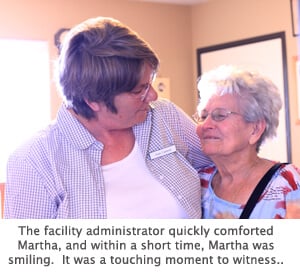
3) This facility allows and encourages their residents to help out with the day-to-day chores at the facility, such as folding towels to doing dishes. Jen stressed that they never *make* their residents resident was happy once she rejoined the groupdo chores, but she has found that many of them enjoy doing it, which gives them a sense of purpose and ownership in their home/facility. Doing simple chores also keeps them busy, and their minds off of things that may be upsetting to them.
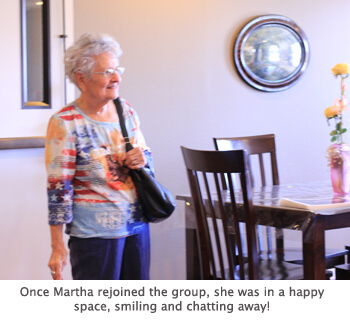
4) This facility also allows and encourages co-habitation – meaning they encourage residents to live in the same room with their spouse, or another ‘roommate.’ The bathrooms are “Jack and Jill” (or shared). Having a roommate, or a spouse with you will obviously help to minimize isolation issues.
5) They encourages families to visit, and stay at the facility with their loved one if needed during difficult times
6) Encouraging staff to bring pets or grandchildren to visit the facility. There’s nothing quite as effective as a lively 5 year old to brighten the mood at a facility.
I was amazed at how willing most of the residents were to stay in the main areas for most of the day. Jen explained that this is entirely by choice with the majority of her residents. She explained that families will often tell her that “our mother will never go out of her room” if she moves into her facility. However, within a short period of time, those ‘stubborn’ residents come out on their own, and spend most of the day in the company of their housemates.
Of course, different facilities may employ different strategies to deal with grief and loneliness, however, what I witnessed with Martha and her facility administrators and staff seemed to be an effective set of efforts that I think would work well in most any assisted living or long-term care environment: Keeping your residents engaged, feeling useful, and connected with those they live with and love.
Responses to this article:
Sarah Wrote
The picture you include is so powerful – Martha overcoming her grief. Brought me to tears nearly.
February 4 2016 at 3:21 pm
Jackie Wrote
Especially now that we are coming up on the holidays, we need to make the extra effort to keep in touch with all of our family members who might be alone, or grieving.
November 1 2011 at 4:42 pm
Minnie Wrote
The photos are very telling – how people’s emotions can turn on a dime – especially seniors who may be dealing with the loss of their spouse.
May 2 2011 at 2:43 pm
No Obligation
Assisted Living with Managing and Minimizing Grief and Loneliness in an Assisted Living Facility or Long-Term Care Environment


